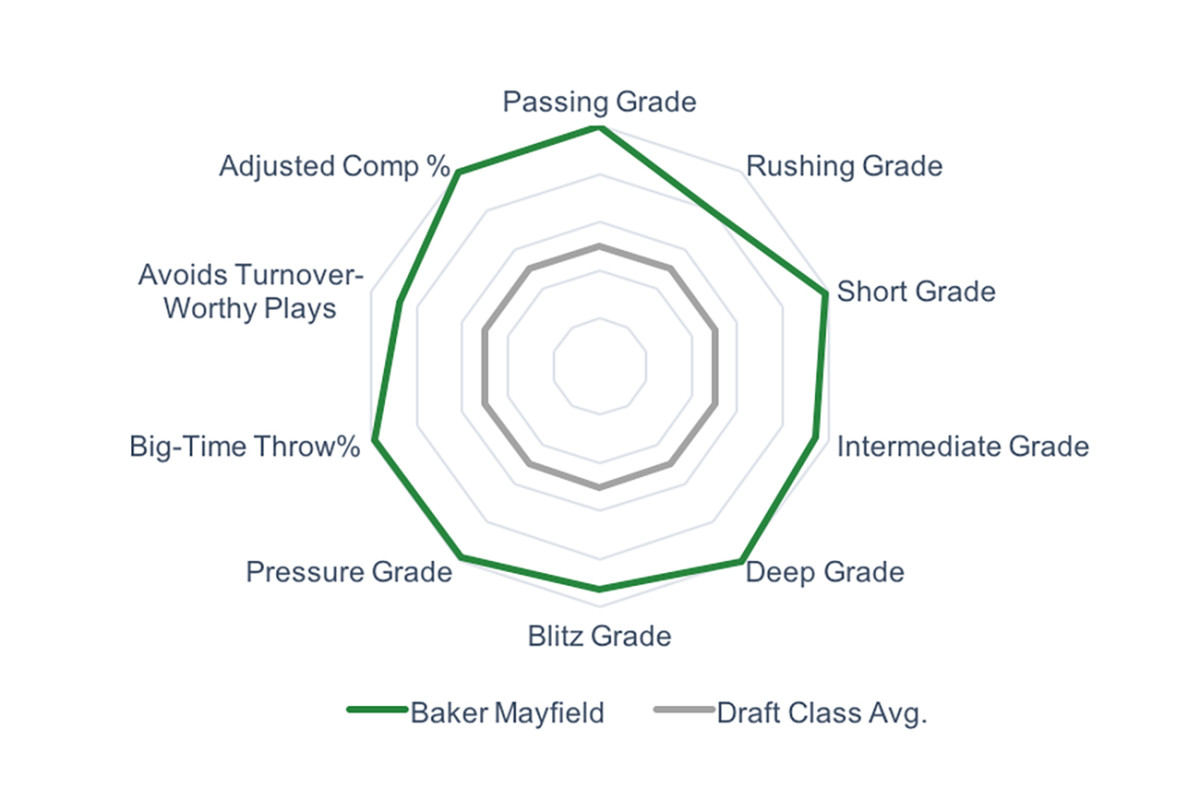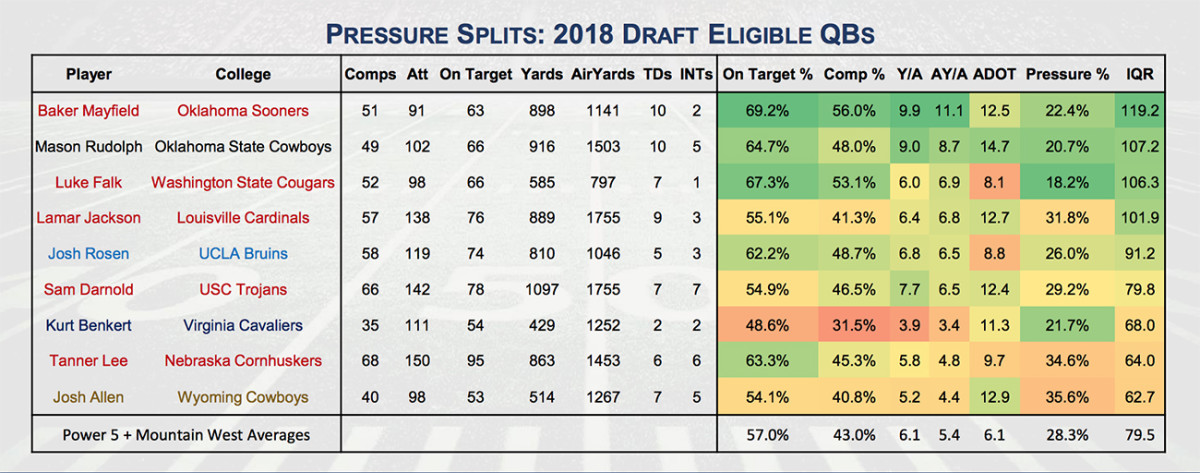What Analytics Say About Baker Mayfield

Part 9 of our draft season series on Baker Mayfield, the 2018 draft’s most fascinating prospect on and off the field
At some point during the NFL combine, between the MRIs and the 15-minute team interviews and the early-morning drug tests, almost every prospect takes a little-known test known as the AIQ, or Athletic Intelligence Quotient. Dr. Scott Goldman and Dr. Jim Bowman have spent the last 15 years developing the exam, administered on a touchscreen and intended to improve upon the methodology of the Wonderlic test, the longtime benchmark for intelligence testing at the combine still in use today.
You’ve probably never heard of the AIQ, and that’s by design; two teams are under contract with Bowman and Goldman’s company—Athletic Intelligence Measures—and purchase the rookie data in full. (The company does not disclose the names of its clients.) About a half dozen additional teams each year buy portions of the data (typically, the test scores for the Top 100 prospects on their boards). The company has administered more than 4,000 tests across each of the major American sports leagues, and started administering the test at the combine in 2012.
“Years ago, we discovered the Wonderlic was the only test that was used to measure intelligence at the combine, and that was based off a theory from 1934,” Goldman says. “It’s language-dependent, and it has socioeconomic and cultural biases. So we spent years looking at all the forms of intelligence and cognitive abilities that impact unsolvable puzzles.”
They debuted the test with the NFL in 2012, testing on a limited basis at the combine, and for the last two years they’ve tested each prospect invited to the combine. Now that they’ve tested thousands of future pros, they’re beginning to see results.
“I’m proud of this,” Goldman says. “We’ve found a statistically-significant correlation between our test and on-field performance, and this is the first test I’m aware of that has found that in the NFL. Players with a high AIQ tend to get on the field sooner and stay on the field longer.”
Why are you hearing about the AIQ now? One of the two teams that subscribes fully to the testing service already has its franchise quarterback. The other team is not a perennial winner, picks in the top half of the first round this year and is one of the handful of teams most interested in drafting Baker Mayfield, the subject of The MMQB’s ongoing series. Goldman declined to confirm the performance of specific players, but did acknowledge a QB prospect this year scored in the Top 100 on the AIQ all-time—out of more than 4,000 tests—and is the second-highest scoring quarterback out of 63 who have taken the test since 2012. Two league sources, who asked for anonymity to discuss the testing results of a prospect, confirmed it was Mayfield.
“It’s just one piece of data, Goldman says. “If an athlete does really well, that’s great. If they don’t, that’s great too, because now you have the information.”

The AIQ is one of the many innovations in analytics that have found a marketplace at the NFL combine. While the league has a reputation for lagging behind the NBA and Major League Baseball in its teams’ embrace of analytics, new ventures emerge every year with the goal of recognizing and cataloguing the vast pool of data to be mined from college prospects. Whether it’s a new way to measure intelligence or a fresh look at on-field résumés, NFL coaches and executives are introduced to innovations in scouting year-round, and many of those conversations take place at the combine.
A survey of those on the cutting edge of this cottage industry gives us analysis of prospects—in this case, Mayfield—independent of subjective concerns like off-field behavior. Pro Football Focus, for instance, publishes nary a word about a prospect’s “intangibles” in its analysis; their focus since introducing a grading scale in 2007 has been eliminating processes in which opinion rules over analysis. This year at the combine they privately introduced to teams a new metric that seeks to reduce ambiguity in the often subjective debate over a quarterback’s accuracy: ball location.
PFF applied its new metric to last year’s quarterback draft class and this year’s top six—Josh Allen, Sam Darnold, Lamar Jackson, Mayfield, Josh Rosen and Mason Rudolph. They used four major categories to chart the specific point on the receiver’s body where the ball was placed—Accurate (perfect), Frame (on-target, step below perfect), Catchable Inaccurate (catchable, but less than ideal ball location), Inaccurate (uncatchable). “We’re trying to be very specific,” says PFF senior analyst Steve Palazzolo. “Did you put it on his front number in stride? Did you hit him on his frame? We give the QB the benefit of the doubt if it’s a little bit inaccurate but thrown away from the defender.”
They also tracked the yards after the catch gained by the receiver on each type of throw in order to demonstrate the value of the accuracy grade. An accurate (perfect) pass, for instance, carries an expected 2.8 yards after the catch (this is an average across all types of routes). A catchable inaccurate pass averages 1.0 YAC. The results:
Mayfield: 64.9%
Darnold: 62.1%
Rosen: 54.1%
Allen: 51.0%
Rudolph: 50.6%
Jackson: 49.0%
“We found there’s a pretty big difference between Mayfield, Darnold and the rest,” Palazzolo says.

Ben Solak at NDT Scouting took his own look at ball placement and split all throws into two fields—clear window and tight window. In Mayfield’s 2017 season he found 68 tight windows (compared to 261 clear windows) and while Mayfield’s completion percentage dipped from 82% on clear windows to 41% on tight windows, his ball placement remained consistent. Of course, these metrics lump in all sorts of throws, from shallow crosses to screen passes to quick slants. During Part 5 of our series on Mayfield, former Seahawks offensive coordinator Darrell Bevell noted the Oklahoma offense didn’t require Mayfield make some of the high-difficulty throws he’ll be asked to make on a regular basis in the NFL.
“You don’t see all the throws,” Bevell said. “And it’s hard to tell velocity from tape. You don’t see him throw that corner route from the pocket, or make very many go ball throws, or throw the deep crossing routes. There’s not enough to say if he’s good or not at that.”
Sports Info Solutions, which supplies college football data to ESPN and works with several NFL teams, found that while Mayfield’s Oklahoma offense isn’t heavy on NFL throws, Mayfield is among the best in college football when called upon to make them. Filtering for all passes in 2016 and ’17, thrown from the pocket, 15 or more yards downfield (Dig, Corner, Post, Seam, Go, Sluggo, Hitch & Go, Post Corner, Corner Post, Out & Up), the data shows that Mayfield is 31st in FBS over the last two season on these types of attempts, but 10th in completions and yards, with 22 touchdowns and four interceptions.
“Interestingly, the so-called big-armed top 3 are all below Mayfield on the list,” says Matt Manocherian, director of football development at Sports Info Solutions and a former scout with the Saints and Browns. “Darnold is just two behind Mayfield in completions but he lags in yardage and touchdowns despite more attempts, and his rate stats are downright ugly. Rosen’s rate stats are average, with the exception being that he has 11 touchdowns to zero interceptions on these throws. Finally, Josh Allen ties for 25th in completions, but like Darnold, his rate stats are troubling.”
PFF, cognizant of the popular opinion that Mayfield and others thrive in an offenses heavily dependent on throws with a lower skill requirement that what will be asked of them in the NFL, also isolated the routes commonly known as “NFL throws.”
“We found all of the throws that have high variances as far as QB skill, and we threw those into an NFL throws bucket,” Palazzolo says. “Even when you separate quote-unquote NFL throws, Baker still comes out on top.”
Pro Football Focus has been uniform in its assessment that Mayfield is the top quarterback in the draft based on the tape, and he winds up as the No. 1 overall selection in all of their spring mock drafts. One of their biggest selling points for the former Oklahoma quarterback is his ability to complete passes under pressure. From 2015-17, in each of his three seasons as a starter at Oklahoma, PFF has Mayfield ranked No. 1 in passer rating under pressure among qualified quarterbacks.
The reasons this metric weighs so heavily in the minds of many analysts is self-evident: As one of the first quarterbacks chosen at the top of the first round, Mayfield can expect substandard offensive line play, and Mayfield, at a shade over 6-feet, is the shortest passer in consideration for the first round, an assumed disadvantage when throwing under pressure.
Sports Info Solutions is in agreement with PFF on Mayfield’s abilities under pressure. Their proprietary quarterback metric, IQR (Independent Quarterback Rating) accounts for events out of the passer’s control, including dropped passes and dropped interceptions. In 2017, Mayfield earned the highest IQR on 91 attempts under pressure by a mile—his 119.2 rating was better than Mason Rudolph by 12 points, and blew away Rosen (91.2), Darnold (79.8) and Allen (62.7). Solak at NDT Scouting logged just 79 throws under pressure last season for Mayfield, compared to Sports Info Solutions’ 91, but found, similarly, that Mayfield’s accuracy on those throws suffered only a “minimal to average drop-off” from .948 to .911.

But the numbers, on their face, can be deceiving, Manocherian says. “An interesting thing we’ve learned about “Under Pressure” stats is that they often have a lot more to do with the QB’s propensity to hold the ball than it is about the offensive line,” he says.
PFF’s analysts logged 11 sacks that were all or mostly Mayfield’s fault, rather than the fault of his offensive line. That number led FBS quarterbacks last year, according to PFF. “There are some plays where he’s almost inviting pressure,” Palazzolo says. “There are a few plays where he holds the ball a little bit long and instead of making a throw within the structure of the offense he looks to make a play outside of structure a little bit too much. He will look to make a big play instead of the easy throw. That will be an adjustment for him.”
Solak noted that Mayfield’s passes tend to float when he can’t set his feet, and when “bodies obstruct his throwing hallway, in which he is forced to a higher release point due to his smaller frame.
“Teams running strict timing offenses should steer clear of Mayfield—but he doesn’t strike me as much of a Bill Belichick guy anyway.”
Mayfield might not be Belichick’s cup of tea, on or off the field, but somebody will fall in love with him, whether it’s the team that values the AIQ, IQR, or any of the numerous advanced metrics finding audience with NFL teams this offseason. Taken as a whole, the analytics paint the picture of an NFL-ready quarterback capable of making difficult throws under pressure, whose existence within an offense prioritizing RAC yards over air yards might have undersold his ability.
Or he could just be, as his critics have suggested, a mediocre passer who has benefitted from a successful offensive system and will struggle with both the off-field and on-field responsibilities of life in the NFL. The two-time walk-on has been compared to everyone from Brett Favre to Johnny Manziel, from Drew Brees to Ryan Leaf.
One thing is becoming clear: There’s nothing average about Baker Mayfield.
• Question or comment? Email us at talkback@themmqb.com.
